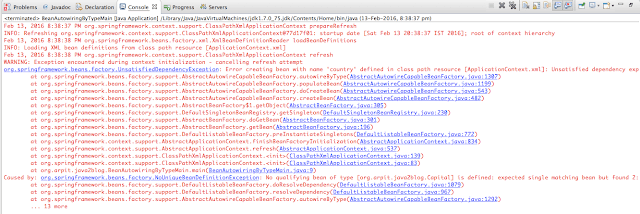Table of Contents
Spring autowiring by constructor is similar to autowiring by type but it is applied to constructor argument. If more than one bean property matches, then it throws fatal exception.


Below digram will make it clear:

For example:
I am taking example of autowire by “constructor” here.It will be almost same as Dependency injection via setter method with some changes in XML configuration file.
1.Country.java:
This is simple pojo class having some attributes so here country has name and object of Capital class.
Create Country.java under package org.arpit.java2blog.Copy following content into Country.java.
|
1 2 3 4 5 6 7 8 9 10 11 12 13 14 15 16 17 18 19 20 21 22 23 24 25 26 27 28 |
package org.arpit.java2blog; public class Country { String countryName; Capital capitalObj; public Country(String countryName, Capital capitalObj) { super(); this.countryName = countryName; this.capitalObj = capitalObj; } public String getCountryName() { return countryName; } public void setCountryName(String countryName) { this.countryName = countryName; } public Capital getCapitalObj() { return capitalObj; } public void setCapitalObj(Capital capitalObj) { this.capitalObj = capitalObj; } } |
2.Capital.java
This is also simple pojo class having one attribute called “capitalName”.
Create Capital.java under package org.arpit.java2blog.java.Above Country class contains object of this class.Copy following content into Capital.java
|
1 2 3 4 5 6 7 8 9 10 11 12 13 14 15 16 |
package org.arpit.java2blog; public class Capital { String capitalName; public String getCapitalName() { return capitalName; } public void setCapitalName(String capitalName) { this.capitalName = capitalName; } } |
3.BeanAutowiringByContructorMain.java
This class contains main function.Create BeanAutowiringByConstructorMain.java under package org.arpit.java2blog.Copy following content into BeanAutowiringByConstructorMain.java
|
1 2 3 4 5 6 7 8 9 10 11 12 13 14 15 16 17 18 |
package org.arpit.javapostsforlearning; import org.springframework.context.ApplicationContext; import org.springframework.context.support.ClassPathXmlApplicationContext; public class BeanAutowiringByConstructorMain{ public static void main(String[] args) { ApplicationContext appContext = new ClassPathXmlApplicationContext("ApplicationContext.xml"); Country countryObj = (Country) appContext.getBean("country"); String countryName=countryObj.getCountryName(); String capitalName=countryObj.getCapitalObj().getCapitalName(); System.out.println(capitalName+" is capital of "+countryName); } } |
You can note here that we have used ClassPathXmlApplicationContext for getting bean here.There are various ways for getting beans.In hello world example we have used XmlBeanFactory for getting beans.
4.ApplicationContext.xml
|
1 2 3 4 5 6 7 8 9 10 11 12 13 14 |
<?xml version="1.0" encoding="UTF-8"?> <beans xmlns="http://www.springframework.org/schema/beans" xmlns:xsi="http://www.w3.org/2001/XMLSchema-instance" xmlns:aop="http://www.springframework.org/schema/aop" xsi:schemaLocation="http://www.springframework.org/schema/beans http://www.springframework.org/schema/beans/spring-beans-3.0.xsd"> <bean id="country" class="org.arpit.java2blog.Country" autowire="constructor"> <constructor-arg index="0" type="java.lang.String" value="India" /> </bean> <bean id="capitalObj" class="org.arpit.java2blog.Capital"> <property name="capitalName" value="Delhi" /> </bean> </beans> |
5.Run it
When you will run above application,you will get following as output.
|
1 2 3 |
Delhi is capital of India |
What if two properties of class have same datatype:
Change ApplicationContext.xml as below:
|
1 2 3 4 5 6 7 8 9 10 11 12 13 14 15 16 17 18 |
<?xml version="1.0" encoding="UTF-8"?> <beans xmlns="http://www.springframework.org/schema/beans" xmlns:xsi="http://www.w3.org/2001/XMLSchema-instance" xmlns:aop="http://www.springframework.org/schema/aop" xsi:schemaLocation="http://www.springframework.org/schema/beans http://www.springframework.org/schema/beans/spring-beans-3.0.xsd"> <bean id="country" class="org.arpit.java2blog.Country" autowire="constructor"> <constructor-arg index="0" type="java.lang.String" value="India" /> </bean> <bean id="capital1" class="org.arpit.java2blog.Capital"> <property name="capitalName" value="Delhi1" /> </bean> <bean id="capital2" class="org.arpit.java2blog.Capital"> <property name="capitalName" value="Delhi2" /> </bean> </beans> |
In above xml, we have declared two capital beans,now how it will autowire.
Answer: It won’t.
When you run above program, it will give you below exception:
It will give you below exception.

Was this post helpful?
Let us know if this post was helpful. Feedbacks are monitored on daily basis. Please do provide feedback as that\'s the only way to improve.



This is very good Tutorials. Thanks for your efforts. I will share your website with my friends. Thanks.